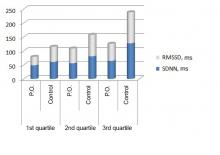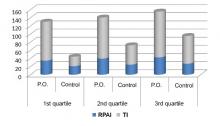Heart rate variability based sport-specific adaptation process in Paralympic cross-country skiers with visual impairments
ˑ:
Dr.Hab., Professor O.A. Churganov1
Dr.Med., Professor E.A. Gavrilova1
PhD Y.V. Yakovlev3
M.D. Tuzlukova4
PhD P.K. Kuznetsov5
1North-Western State Medical University named after I.I. Mechnikov, St. Petersburg
2Budyonny Military Academy of the Signal Corps, St. Petersburg
3St. Petersburg Medical and Physical Training Center of the Krasnogvardeisky District, St. Petersburg
4North-West Institute of Management, St. Petersburg
Keywords: Paralympic athletes with visual impairments, heart rate variability data, Paralympic sports, Firstbeat
Introduction. Nowadays the requirements for Paralympic sports are constantly increasing. This is especially true for athletes with visual impairments. Individual research works that have such specific keywords as "blind sports" do not contain any experimental solutions to the issues affecting athletes with visual deprivation, and, above all, to the problem of adaptation of the blind to sports activities [2, 6, 8]. However, awareness of the adaptation peculiarities and their consideration in the training process can help considerably optimize the management of the training process for Paralympians with visual impairments [5].
Objective of the study was to analyze the heart rate variability (HRV)-based sport-specific adaptation process in cross-country skiing Paralympians with visual impairments.
Methods and structure of the study. Sampled for the study were elite Paralympic cross-country skiers (n=42) split up into an Experimental Group (EG, n=23) of Paralympic athletes with visual impairments and Reference Group (RG, n=19) of healthy members of the Russian national team.
We made a statistical estimate of the required number of empirical groups using the statistical methods. The comparison groups were formed on a random basis by assessing both the effects of training loads on the body of individual athletes and the training effect (TE) size using the "FirstBeat SPORT" computer-based system (Firstbeat, Finland) and the "BodyGuard" sensor. The experiment involved the analysis of the quiescent-state versus high-intensity-work HRV in pre-season. HRV was recorded for 5 min at rest in the morning on the first day of the training camp before and immediately after the practice race to study the dynamics of changes in the RCG rates in the Paralympians versus the Reference Group (RG) athletes.
HRV was analyzed using the computer complex "Cardiometer-MT" ("Micard Lana" LLP) (State Register № 98/219-67). The RCG analysis was performed in accordance with the 1996 International Standard and recommendations of "FirstBeat". The statistical analysis was carried out using the STATISTICA 6.0 software package (StatSoft Inc., Tulsa, OK, USA), as well as the domestic statistical package STADIA.
Results and discussion. The quiescent-state RCG analysis in two groups showed that the HRV rates in the Paralympians were significantly lower as opposed to the RG athletes. Thus, the average values of the total variability index (SDNN + RMSSD) in two groups of athletes are presented in Fig. 1.

Fig. 1. SDNN (p<0.01) and RМSSD (p<0.02) rates in Paralympians (P.O.) and Oympians (RG)
The SDNN values in the Paralympic group were 44.3% (p<0.01), and the RMSSD values were lower by 45.3% (p<0.02) than in the RG.
The 2nd quartile (median) of the total spectrum power in the Paralympians (3210.6 ms2) was 76.5% lower than that in the RG (5666.0 ms2), p<0.01. All the spectral parameters in the Paralympians were lower than in the RG athletes, however, the central control contour indices differed statistically significantly: LF (p<0.01) and VLF (p=0.04). This testifies to the reduced adaptive capabilities of the Paralympians as opposed to the RG athletes.
We detected some statistically significant differences in all integrated RCG indicators between the groups. Fig. 2 illustrates the distribution of the regulation process adequacy index (RPAI) and tension index (TI) of RCG in two groups of athletes.

Fig. 2. Distribution of RPAI and TI values in group of Paralympians (P.O.) and RG athletes (p<0.05)
This distribution reflects a significantly more pronounced tension of the adaptation mechanisms and regulatory systems in the blind athletes (EG) at rest as compared to the athletes of the RG.
Therefore, in the pre-season, the quiescent-state HRV rates in the Paralympic cross-country skiers with visual impairments were significantly lower, while centralization of their hearth rhythm was significantly higher as opposed to the Olympians.
However, the ultimate functional state of the athletes at rest is characterized by the high variability and low centralization rates [1, 2, 4]. The data obtained testify to the decline of the quiescent-state functionality economizing function, decrease in the responsiveness and high physiological "cost" of adaptation of the Paralympians with visual impairments to sports activities as opposed to the RG.
The dynamics of the quiescent-state versus high-intensity-work RCG in two groups was studied based on the HRV analysis performed before and immediately after the training session on the first day of the training camp. The mean TE values on the day of the RCG recording did not differ significantly in two groups (3.5±0.17 versus 3.8±0.24 c.u. in the RG, p>0.05). According to the study findings, the greatest differences between the RG/EG after exercise were observed in terms of the following indicators: dX, VRI, VLF, LF/HF. The latter indicator differed between the groups by 42 times.
This is due to the insignificant inclusion of the central control contour in the Paralympians versus the RG. Athletes who are more successful are known to have more active central contour of the heart rate regulation, which is deemed a display of mobilization of the functional reserves.
The low central regulatory contour mobilization reflects considerable overloading of the central contour at rest, as verified by the analysis of the RCG rates in two groups. It turned out that, when at rest, the Paralympians were characterized by the predominant central control contour (I and II type of regulation according to N.I. Shlyk), which was observed in 43.9% of Paralympians versus 10.6% of the RF athletes (p<0.001), i.e. 4 times more often. At the same time, the types of regulation being the most optimal for sports activities - III and IV - were found in 56.1% of Paralympians, against 89.5% of athletes of the RG, i.e. 1.6 times less often (p<0.05).
Consequently, as opposed to the RG athletes, the process of adaptation of the EG cross-country skiers to training workloads was characterized by the decline of the quiescent-state functionality economizing function and the low regulatory system mobilization rates, which was associated with the low level of development of their autonomous control contour. This may be due to the fact that, firstly, absent (limited) vision was compensated by tension of other bodily systems. Secondly, low regulatory capabilities may be due to the sedentary lifestyle of the blind preceding their sports activities. Thirdly, of course, the Paralympians’ fitness level was much lower than that of the RG athletes. It also caused tension of the adaptation mechanisms. This leads to overloading and even deterioration of the central control contour at rest, and hence its low response rates under workload. Accordingly, the "cost" of such adaptation increases significantly, while the level of health decreases. This is facilitated by a rather low initial autonomous regulation contour.
The only way out is to develop the autonomous control contour. The studies conducted by N.N. Nezhkina in 2009-2011 indicated high effectiveness of training of the autonomous control contour using static exercises [8]. M.V. Tregubova (2008) proved that inclusion of static loads to the training process contributes to faster recovery - by 1.5 times [9]. According to N.A. Fudin (2015), under static loads, the brain circulation autoregulation improves, which is extremely important for the blind and visually impaired [10]. The fact of inclusion of the autonomous contour to the process of training indicates not only the level of adaptation of the athlete's body, but also his fitness level and competitive success.
At the same time, the blind should be trained in terms of reduced tension of the central control contour in the resting state using various rehabilitation means, in particular massage. This will eliminate overexploitation of the athlete’s central control contour at rest and expand its functional capacities under workload and subsequent successful recovery.
Conclusions. The analyses and the HRV data were indicative of the Paralympic EG adaptation to the training workloads claiming higher physiological "cost" versus the RG, as verified by the significant decline of the quiescent-state functionality economizing function in the EG and the low regulatory system mobilization rates under physical workloads. Monitoring of the rhythmograms obtained in the Paralympians with visual impairments gives prognostic information for analyzing the correspondence of physical workloads to the functional capacities of the athlete's body.
References
- Aghajanyan N.A. Sorevnovatelny stress u predstaviteley razlichnykh vidov sporta po pokazatelyam variabelnosti serdechnogo ritma [Competitive stress among representatives of various sports according to heart rate variability indices]. Teoriya i praktika fizicheskoy kultury, 2006, no. 1, pp. 2-5.
- Baryaev A.A. Sovershenstvovanie sistemy sportivnoy podgotovki v golbole (sport slepykh) na osnove primeneniya kompleksnogo kontrolya [Improving sports training system in goalball (blind sports) using integrated control]. Spetsialnoe obrazovanie, 2016, no. 1, pp. 16-24.
- Baryaev A.A., Evseev S.P., Misharina S.N. et al. Osobennosti nauchno-metodicheskogo soprovozhdeniya protsessa podgotovki sportsmenov-paralimpiytsev [Features of scientific and methodological support of training process of Paralympic athletes]. Teoriya i praktika fiz. kultury, 2008, no. 3, pp. 13-17.
- Gavrilova E.A., Shlyk N.I. Analiz variabelnosti serdechnogo ritma v kontrole za trenirovochnoy i sorevnovatelnoy deyatelnostyu sportsmenov na primere lyzhnykh vidov sporta [Study of heart rate variability in control of athletes' training and competitive activities (case study of ski sports]. Lechebnaya fizkultura i sportivnaya meditsina, 2016, vol. 133, no. 1, pp. 17-23.
- Gavrilova E.A. Variabelnost ritma serdtsa i sport [Heart rate variability and sport]. Fiziologiya cheloveka, vol. 42, no. 5, pp. 121-129.
- Gavrilova E.A., Churganov O.A. Prognozirovanie aerobnyih sposobnostey vysokokvalifitsirovannykh lyzhnikov po dannym variatsionnoy pulsometrii [Prediction of aerobic abilities of elite skiers according to variation pulsometry]. Vestnik sportivnoy nauki, 2012, no. 4, pp. 3-5.
- Evseev S.P., Shelkov O.M., Churganov O.A. et al. Nauchno-metodicheskoe soprovozhdenie paralimpiyskogo sporta [Scientific and methodological support of Paralympic sports]. Adaptivnaya fizicheskaya kultura, 2014, vol. 58. no. 2, pp. 7-12.
- Nezhkina N.A., Kuligin O.V., Chistyakova Y.V. Kharakteristika fizicheskogo razvitiya i fizicheskoy podgotovlennosti studentov 16-17 let v zavisimosti ot tipa ikh iskhodnogo vegetativnogo tonusa [Characteristics of physical development and physical fitness of students aged 16-17 years based on their initial vegetative tonus type]. Lechebnaya fizkultura i sportivnaya meditsina, 2011, vol. 89, no. 5, pp. 25-30.
- Tregubova M.V. Osobennosti sokratitelnoy deyatelnosti serdtsa dzyudoistov 16-20 let massovykh razryadov pri razlichnoy intensivnosti fizicheskikh nagruzok [Features of cardiac contractile activity in mass judokas aged 16-20 years at different intensity of physical loads]. PhD diss. abstract. Chelyabinsk, 2008, 137 p.
- Fudin N.A., Eskov V.M., Filatova O.E. et al. Utomlenie cheloveka pri staticheskoy i dinamicheskoy fizicheskoy nagruzke i mekhanizmy adaptatsii [Fatigue of man after static and dynamic exercise and adaptation mechanisms]. Vestnik novykh meditsinskikh tekhnologiy, 2015, no. 1, pp. 14-16.
Corresponding author: churganov@inbox.ru
Abstract
Objective of the study was to analyze the heart rate variability (HRV)-based sport-specific adaptation process in cross-country skiing Paralympians with visual impairments. Sampled for the study were elite Paralympic cross-country skiers (n=42) split up into an Experimental Group (EG, n=23) of Paralympic athletes with visual impairments and Reference Group (RG, n=19) of healthy members of the Russian national team. The experiment was designed to test the quiescent-state versus high-intensity-work HRV in pre-season. The analyses and the HR variability data were indicative of the Paralympic EG adaptation to the training workloads claiming higher physiological costs versus the RG, as verified by the significant decline of the quiescent-state functionality economizing function in the EG and the low regulatory system mobilization rates under physical workloads. It was found that the Paralympic athletes’ HRV data provide a sound basis for the training process and progress being efficiently customized to the actual individual fitness rates.



